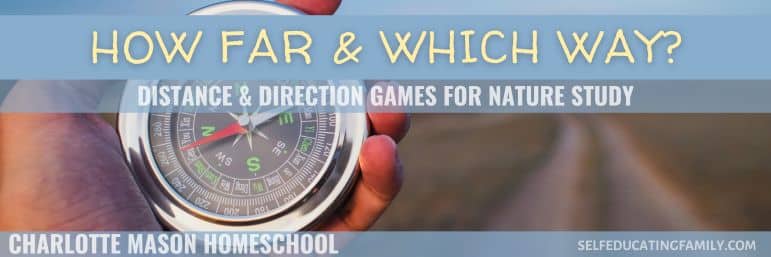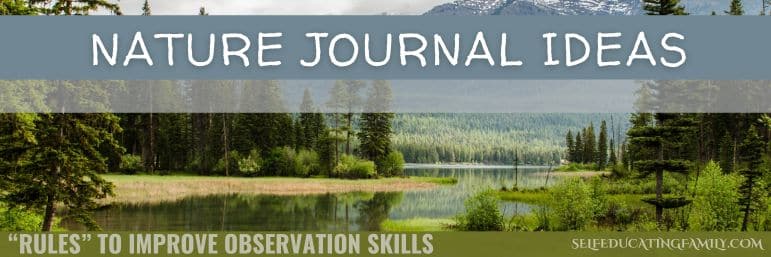What’s inside: Nature Study “Distance” Games for Preschoolers and older! Here is the final “game” that Charlotte Mason recommended for engaging kids without formal lessons. It’s really a bunch of games with the theme of “How to tell distance”.
This post may contain affiliate links. If you find my content valuable and make a purchase through one of my links, I will earn a commission at no cost to you, which helps me keep this blog going so I can help you even more! I recommend products I trust and/or use myself, and all opinions I express are my own. Read the full disclaimer here.
Games for Nature Study
Charlotte Mason suggested several games for nature study, especially for age groups which included preschoolers – those too young to begin formal lessons (under age 6 or so).
We looked at “Sight-seeing” and “Picture Painting” in an earlier post. These games helped to train observation skills, visual memory, and descriptive language, as well as many other skills.
And today we will tackle the Distance Games.
There are lots of variations in learning how to tell how far something is or how big something is or which direction it is in.
Source
I’ll be quoting Charlotte Mason (CM) extensively again for these descriptions. The quotes are from Volume 1 of her Home Education Series. If you don’t have a copy, you can enjoy a free online version.
Geography and the “Distance Game”
Out-of-doors Geography is the heading under which we find the distance games.
Distance is one of these [games], and the first idea of distance is to be attained by what children find a delightful operation.
Charlotte Mason
She describes the simplest of these games – knowing how to measure a distance by pacing it out.
A child walks at his usual pace; somebody measures and tells him the length of his pace, and then he measures the paces of his brothers and sisters. Then such a walk, such a distance, here and there, is solemnly paced, and a little sum follows––so many inches or feet covered by each pace equals so many yards in the whole distance. Various short distances about the child’s home should be measured in this way; and when the idea of covering distance is fully established, the idea of times as a means of measurement should be introduced. The time taken to pace a hundred yards should be noted down. Having found out that it takes two minutes to pace a hundred yards, children will be able for the next step––that if they have walked for thirty minutes, the walk should measure fifteen hundred yards; in thirty-five minutes they would have walked a mile, or rather seventeen hundred and fifty yards, and then they could add the ten yards more which would make a mile. The longer the legs the longer the pace, and most grown people can walk a mile in twenty minutes.
After distance comes direction
Direction starts with knowing the position of the sun.
The Position of the Sun.––And not only this: the children should be taught to observe the position of the sun in the heavens from hour to hour, and by his position, to tell the time of day. Of course they will want to know why the sun is such an indefatigable traveller, and thereby hangs a wonderful tale, which they may as well learn in the ‘age of faith,’ of the relative sizes of sun and earth, and of the nature and movements of the latter.
Older students may begin jotting down the position of the sun (“older” means that they keep notebooks, generally older than age 6, but it could be older). They can track the sun’s rising and setting each day over the course of a year in their nature notebooks.
Go outside with them for the occasional sunrise or sunset. Then they can begin to note direction.
- The sun rises in the East and sets in the West.
- If you stand with the rising sun on your right and the setting sun on your left, you are facing north and South is to your back.
- CM suggests then making note of your neighborhood – If you are standing in front of your home and facing North, where are the houses that are West of your home? Which direction does the street run? And so on.
- Which direction does your front door face? What about the windows in your home?
- If you observe the sun rising or setting, which way do the shadows fall at those times. Which way are the shadows at midday?
Call these little exercises by a fun name and you have just created a distance or direction “game” to enjoy with your kids. You can say, “Let’s play ‘FIND THE SUN’ or ‘Which Way?’ ” or whatever you called your game.
Next, Finding Direction
If you are somewhere that you have never observed sunrise or sunset, how can you use the shadows to tell you?
- What were the shadows doing if you faced North just after sunrise? What about an hour before sunset?
- Can the shadows of buildings or trees tell you anything?
It’s tiny, little observations every time you are out over the course of years that add up!
Compass Drill
Next comes the compass! Begin simply by having the child hold a compass in his hand and facing North. Slowly turn as you watch the compass.
You begin to see how it works.
In olden times vs future times
We learned how to read a map and follow a trail using a compass. Technology sometimes changes things. I feel like it is difficult to even find somewhere that sells maps anymore!
While you can always learn the new technology as your kids get older – it’s fairly easy to pick up since it tells you how think – it may be better for your child to learn to think first and then pick up technology later.
If you can find a paper map and learn navigation using a compass, that gives a solid foundation for later in life, even if you pick up a technology-based hobby like geocaching when the kids get older. Hobbies like orienteering still have the old skills in many of their competitions and events.
By learning to rely on a map and a compass, you empower future skills like independence in the woods, knowing how to find your way, and being comfortable if you do get lost.
Distance and Direction
Now comes the fun!
You can make your own games or treasure hunts combining distance and direction.
Possible Games:
- Treasure hunts: Teams start in different locations and follow distance and direction to get to the next clue.
- Course mapping: Each kid makes a route to follow with known targets, then trades to see how well their directions worked.
- Creating Plans and Maps: Mapping out indoors or out of doors with familiar spaces. Use distances and include direction on the map.
- Making your own Trail Map: Identify key markers to direct others on a trail to arrive at a particular place.
Use your imagination to create your own games using distance and direction.
By-and-by, when they have learned to draw plans indoors, they will occasionally pace the length of a field and draw their plan according to scale, allowing an inch for five or for ten yards. The ground-plans of garden, stables, house, etc. might follow.
Get out and enjoy
I hope these ideas from Charlotte Mason help you find one more way to enjoy nature with your kids!








